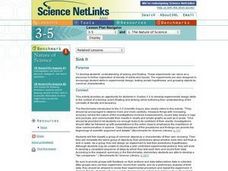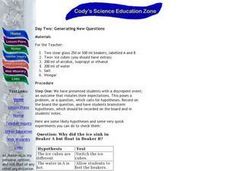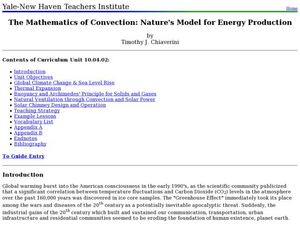Curated OER
Beneath the Sea
Learners build a model of a submersible that will allow them to explore ballasts and how they operate. In this hands on instructional activity students participate in an activity that shows them how to control buoyancy.
Curated OER
Dive In
Learners study how buoyancy, pressure, and light can effect the work of underwater scientists. In this marine science lesson students complete a lab that allows them to better understand how pressure varies with altitude and depth.
Curated OER
Diving Raisins
Young scholars hypothesize and observe what occurs when raisins are dropped in a carbonated liquid. They examine buoyancy and how density effects ascent and descent.
Curated OER
Concrete Canoes
Learners explore and analyze the relationship of buoyancy and displacement needed to make an object float. They examine various boat designs, then design and build clay and aluminum boats that hold a cargo of marbles.
Curated OER
Properties of Matter: "Sink or Swim"
Third graders recognize that different materials have different properties which can be observed such as texture and bouyancy, and compare and contrast, through observation, ability of some objects to float because of action of...
Curated OER
Condiment Diver: The World's Simplest Cartesian Diver
Students examine buoyancy. In this density lesson students form a hypothesis, collect data and draw a conclusion using the data.
Curated OER
What Floats Your Boat?
This open-ended boat building exercise is meant to be part of a three-lesson series on ships. Links to the other two lessons are included. This particular part is mostly a group lab activity in which they build a boat, find its load line...
Curated OER
Sink It
Introduce your class to the concept of sinking and floating. In groups, they classify objects after making predictions about which materials will sink or float. They record their results and create graphs and charts to share with the class.
Curated OER
Sink or Float
Students explore water properties by conducting a class experiment. In this buoyancy lesson, students make predictions as to whether or not specific objects will sink or float in water. Students conduct the experiment and record their...
Curated OER
Day Two: Generating New Questions
Students investigate buoyancy by participating in a lab experiment. In this density lesson, students utilize vinegar and alcohol in beakers and attempt to float different items in them. Students analyze which items float and do not while...
Curated OER
Day Six: Floater What Ifs
Students observe earth science by examining results from an experiment. In this buoyancy lesson, students practice floating different items in two different liquids and identify why certain objects will float and others sink. Students...
Curated OER
Lesson: Can-Do Canoe
Collaborative groups work together with a variety of materials to design an eight-inch canoe that floats for at least three minutes. There is no direct instruction involved in this plan, just a list of materials and a procedure for...
Curated OER
How to Float an Egg
Use the scientific method to experiment with an egg. Your class can examine buoyancy and density by finding how many spoons of salt are needed to float an egg. They can predict, experiment, record data, and analyze results.
Curated OER
The Buoyancy Factor
Students examine why some objects float in water while others sink and the ability of something to float does not depend entirely on its weight. Archimedes' principle is introduced and buoyant force is discussed. Practice calculations...
Curated OER
Buoyancy
Pupils look at clippings of boats. They are able to define the following terms displacement, and density. Students construct a clay boat. After they complete their clay boat pupils answer questions about their clay boats.
Curated OER
Buoyant Boats
Learners design and construct a boat out of aluminum foil and a few other simple materials. The boats then be tested by floating them in water, then adding mass until they sink. They explore the various shapes of boat construction.
Curated OER
Ice Floats
Young scholars explore the changing density of water. In this physics instructional activity, students investigate how an object's density determines whether it will float or sink in water. They explain why this unique property of is...
Curated OER
Science: Floating and Sinking Objects
Second graders discuss why some objects float while others sink. They examine various objects and predict whether or not they will sink or float. Students discover the properties needed for objects to float.
Curated OER
Salinity
Learners take a provided ocean Trivia Quiz in order to start a discussion of the ocean. They then perform an experiment on how the amount of salt in the ocean affects it and varies from ocean to ocean.
Curated OER
Floating Fishes: Boat Sinking Lab
Cut milk cartons in half to make boats and let investigators attempt to sink them. They add dividing walls and observe what happens if marbles are put into only one of the newly formed compartments. Vocabulary is provided: buoyant force,...
Curated OER
The Mathematics of Convection: Nature's Model for Energy Production
High schoolers conduct a series of experiments to investigate density, buoyancy and climate. In this math lesson, pupils design and build a hot air balloon to demonstrate convection. They research and write a paper about solar chimneys.
NASA
The NBL Pool
That is a lot of water. Class groups explore the size of the NASA's Neutral Buoyancy Pool and calculate the volume of water needed to fill it. They then compare that volume to the amount of water needed to fill a pool the size of a...
Curated OER
Pumpkin Play
Have you ever examined a pumpkin and estimated the number of lines it has? For this math lesson, students count the actual number of lines, record and graph the results. They investigate the circumference, weight and buoyancy of the...
NASA
Newton’s Cool in the Pool
Pupils work together to investigate the cooling of NASA’s Neutral Buoyancy Laboratory. Using data collected as the pool cooled, groups determine the values needed in Newton's Law of Cooling equation to model the situation. They...
Other popular searches
- Density and Buoyancy
- Sink Float Buoyancy
- Eggs and Buoyancy
- Buoyancy Force
- Relative Buoyancy
- Buoyancy Boat Design
- Density & Buoyancy
- Buoyancy and Boats
- Water Buoyancy
- Buoyancy Swimming
- Buoyancy Ideas
- Neutral Buoyancy

























